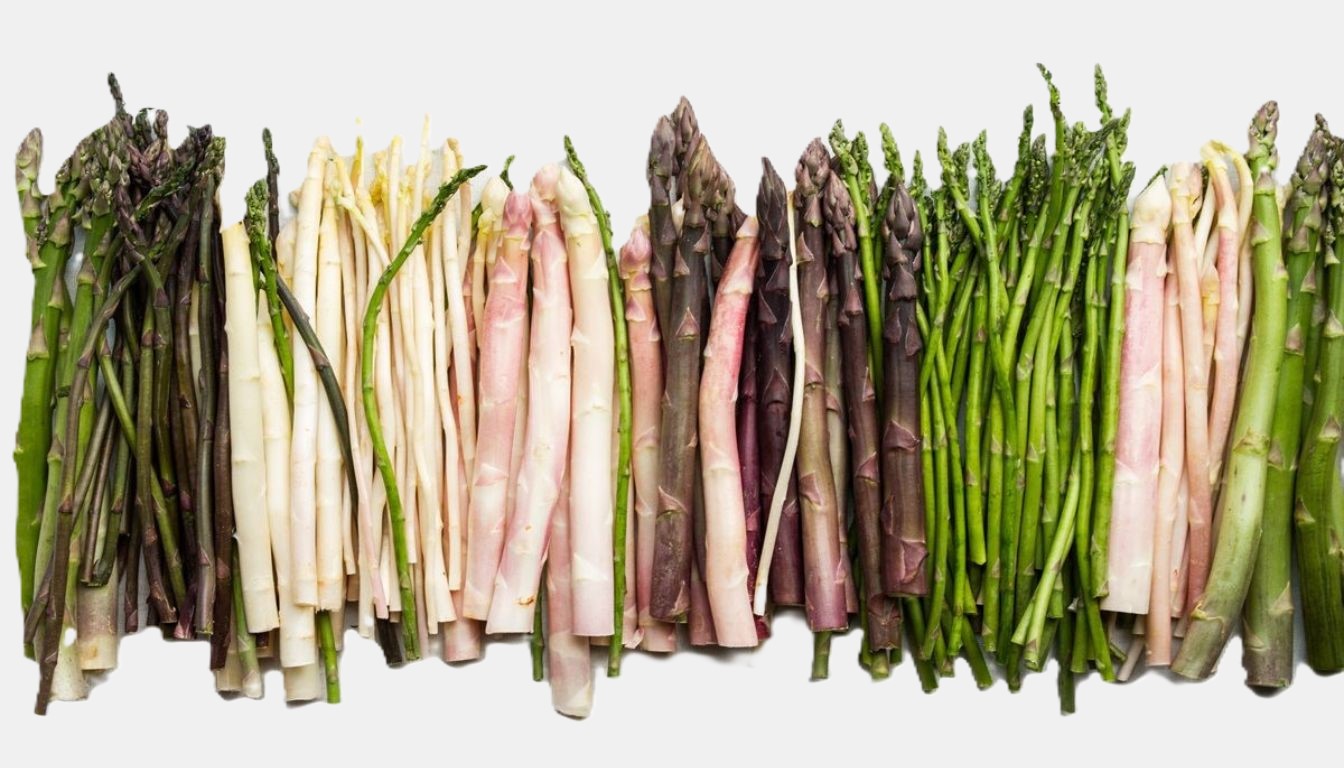Asparagus is more than just a seasonal vegetable; it’s a culinary delight that can elevate any dish. With its unique flavors and textures, this versatile green can transform a simple meal into a gourmet experience. But did you know there are several varieties of asparagus, each with its distinct taste and characteristics?
Overview of Asparagus Varieties
Asparagus grows in several varieties, each offering distinct flavors and characteristics. I find these differences fascinating and essential for cooking. The most common types include green, white, and purple asparagus.
Green Asparagus – Asparagus Varieties: Delicious Gourmet Meal Inspirations
Green asparagus is the most widely recognized variety. It thrives in sunlight, which gives it a vibrant color and rich, earthy flavor. I enjoy its crisp texture and versatility. I can use it in salads, stir-fries, or simply roast it with olive oil and garlic.
White Asparagus
White asparagus grows underground, shielded from sunlight. This lack of light prevents chlorophyll production, resulting in a pale appearance. It boasts a milder flavor and tender texture. Many people pair it with hollandaise sauce for a classic dish that pleases the palate.
Purple Asparagus

Purple asparagus stands out with its unique hue. Its sweetness is more pronounced, thanks to its higher sugar content. This variety often delights my guests at dinner with both appearance and taste. I find it particularly appealing when grilled or served raw in salads.
Other Varieties
Beyond these primary types, various heirloom asparagus varieties exist. ‘Milanese’ features a robust flavor, while ‘Mary Washington’ remains popular for its hardiness and yield. I enjoy experimenting with these heirlooms, discovering each one’s distinct personality.
Each asparagus type brings its flavor and texture to my kitchen. I appreciate how these varieties not only enhance my dishes but also offer a delightful array of colors and tastes for any meal.
Popular Asparagus Varieties
Asparagus comes in various types, each with its unique charm. Let’s explore the most popular varieties that add flavor to our plates.
Green Asparagus – Asparagus Varieties: Delicious Gourmet Meal Inspirations
Green asparagus stands out with its vibrant color and full flavor. This variety thrives in sunlight, resulting in its rich, earthy taste. I enjoy using green asparagus in salads, stir-fries, and roasted dishes. It cooks quickly, making it perfect for weeknight meals. Plus, it’s packed with nutrients, making it a healthy addition to any dish.
White Asparagus
White asparagus has a different story. Grown underground, it lacks sunlight, which keeps it pale and tender. Its flavor is milder, often described as delicate. I find white asparagus pairs beautifully with hollandaise sauce or light dressings. This variety works well in elegant dishes where a subtle taste is desired. Don’t sleep on it at fancy dinners; it adds a touch of sophistication.
Purple Asparagus
Purple asparagus brings a pop of color to the table. The higher sugar content gives it a sweeter flavor. Grilling or serving it raw enhances its visual appeal. I love its surprising sweetness in salads or as a snack. This variety also contains antioxidants, providing a health boost along with its deliciousness. Plus, who can resist something so vibrantly colored on their plate?
Nutritional Benefits of Different Asparagus Varieties
Asparagus offers impressive nutritional benefits across its various types. Each variety packs its own set of vitamins, minerals, and health-boosting compounds.
Green asparagus shines with its rich nutrient profile. It’s loaded with vitamins A, C, E, and K, along with B vitamins like folate. This variety also contains fiber, which supports digestion and encourages gut health. Plus, its antioxidants play a vital role in combating oxidative stress and inflammation.
White asparagus deserves attention for its unique benefits. Although it’s milder in flavor, it’s still a nutritional powerhouse. White asparagus contains essential nutrients, including potassium and vitamin B6. Its lower calorie content makes it a great choice for those looking to maintain a healthy weight.
Purple asparagus stands out visually and nutritionally. Its vibrant hue signals the presence of anthocyanins, powerful antioxidants that help protect cells from damage. This variety also has more sugar, lending a sweeter taste. It’s a great way to satisfy your sweet tooth without compromising health.
Heirloom varieties like ‘Milanese’ and ‘Mary Washington’ bring distinct flavors and benefits. These heirlooms often offer higher levels of certain phytonutrients. They can also enhance the diversity of nutrients in your diet. Enjoying a mix of asparagus varieties ensures a broader spectrum of vitamins, minerals, and flavors.
Incorporating these different asparagus types into meals can maximize their health benefits while keeping your dishes exciting. Eating a colorful plate not only pleases the eye; it also pleases the body! So, whether I’m tossing green asparagus in a salad or roasting purple asparagus on a platter, I’m celebrating the wonderful nutritional benefits of this versatile vegetable.
Culinary Uses of Asparagus Varieties

Asparagus adds a delightful crunch to numerous dishes. Green asparagus shines in salads and stir-fries. I love tossing them in olive oil, garlic, and a sprinkle of salt before roasting. The result? A crisp, earthy addition to my table.
White asparagus provides a different experience. Its mild flavor complements rich sauces like hollandaise. I often serve it with eggs for a brunch that’s hard to top. Dipping those tender stalks into creamy sauces feels luxurious.
Purple asparagus appeals to the eye and the palate. The sweetness surprises me, especially when grilled or served raw in salads. Its vibrant hue brightens the plate, creating an artful display. Plus, it’s a great conversation starter at dinner parties.
Heirloom varieties like ‘Milanese’ and ‘Mary Washington’ bring unique tastes to my kitchen. I enjoy experimenting with these types in various recipes. Each variety offers distinct flavors that elevate simple meals into gourmet experiences. Roasting multiple types together leads to a beautiful and tasty mix.
Asparagus pairs well with many ingredients. Cheese, lemon, and herbs create delightful combinations. I love adding feta and lemon zest for an extra punch. Feel free to experiment with your favorites!
Using asparagus in different forms also adds variety. Try it grilled, steamed, or even pickled. Pickled asparagus makes a great snack or a quirky addition to charcuterie boards. Its versatility knows no bounds.
With these culinary uses, asparagus varieties unlock endless possibilities in the kitchen. Whether enjoying a simple sauté or a fancy soufflé, there’s always a delicious method to savor this wonderful vegetable.
Growing Conditions for Asparagus Varieties
Asparagus thrives in specific conditions that ensure healthy growth and robust flavor. Understanding these needs is key to a successful harvest.
Soil Requirements – Asparagus Varieties: Delicious Gourmet Meal Inspirations
Asparagus prefers well-drained, sandy or loamy soil. Good drainage prevents root rot, fostering healthy plants. The soil’s pH should range from 7.0 to 7.5. Mixing in organic matter, like compost, enhances nutrients and improves soil structure. It’s important to avoid heavy clay soils. These can hinder asparagus roots and stunt growth. Ensuring proper soil conditions helps in yielding a plentiful crop.
Sunlight and Watering Needs
Asparagus loves the sun, requiring at least 8 hours of direct sunlight each day. The full sun promotes strong growth and vibrant flavors. Watering should occur regularly; aim for about 1 inch per week. Consistent moisture is essential but avoid waterlogging. Using a drip irrigation system can be effective. Covering the soil with mulch preserves moisture and suppresses weeds. With the right care, my asparagus plants grow strong and delicious.
Before You Go – Asparagus Varieties: Delicious Gourmet Meal Inspirations

Exploring the diverse varieties of asparagus has truly opened my eyes to the culinary possibilities this vegetable offers. Each type brings its unique flavor and texture to the table. Whether I’m enjoying the earthy richness of green asparagus or the delicate sweetness of purple asparagus, I find that incorporating these varieties into my meals makes each dish feel special.
The nutritional benefits are just the icing on the cake. With the right growing conditions and care, I can enjoy a bountiful harvest that not only enhances my cooking but also supports my health. I encourage everyone to experiment with different asparagus types and discover their favorites. There’s a whole world of flavor waiting to be explored.
Don’t forget to add theherbprof.com homepage to your favourites so you don’t miss out on future articles.
References – Asparagus Varieties: Delicious Gourmet Meal Inspirations
Little Herb Encyclopedia, by Jack Ritchason; N.D., Woodland Publishing Incorporated, 1995
The Ultimate Healing System, Course Manual, Copyright 1985, Don Lepore
Planetary Herbology, Michael Tierra, C.A., N.D., Lotus Press, 1988
Handbook of Medicinal Herbs, by James A. Duke, Pub. CRP Second Edition 2007
The Complete Medicinal Herbal, by Penelope Ody, Published by Dorling Kindersley
Check the Following Article
Ultimate List of Delicious and Nutritious Tropical Fruits
Creatine and Sex Drive: Boost Performance and Libido
Rose Petals Recipes: Elevate Cooking with Floral Flavors
Best Natural Ingredients for Glowing Skin: A Quick Guide
Frequently Asked Questions – Asparagus Varieties: Delicious Gourmet Meal Inspirations
What are the main types of asparagus?
Asparagus primarily comes in three types: green, white, and purple. Green asparagus is vibrant and earthy, while white asparagus, grown underground, has a milder flavor. Purple asparagus is sweeter and visually appealing, making it a great choice for salads and grilling.
How should I grow asparagus?
Asparagus thrives in well-drained, sandy or loamy soil with a pH of 7.0 to 7.5. Ensure it receives at least 8 hours of direct sunlight daily and water consistently to maintain about 1 inch of moisture weekly, avoiding waterlogging.
What are the nutritional benefits of asparagus?
Asparagus is packed with vitamins A, C, E, and K, as well as fiber. Green asparagus offers a rich nutrient profile, while white asparagus is low-calorie and high in potassium. Purple asparagus contains antioxidants, enhancing both its health benefits and flavor.
How can I use asparagus in cooking?
Asparagus is versatile in the kitchen. Green asparagus adds crunch to salads and stir-fries, while white asparagus pairs well with rich sauces like hollandaise. Purple asparagus is great grilled or raw in salads, enhancing both flavor and presentation.
What are heirloom asparagus varieties?
Heirloom varieties, like ‘Milanese’ and ‘Mary Washington,’ provide unique flavors and diverse colors. These distinct types can elevate culinary experiences, offering rich tastes and higher levels of certain phytonutrients for a more exciting meal.

